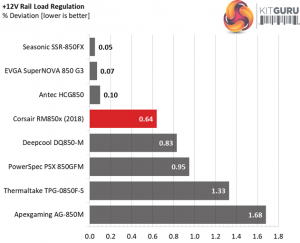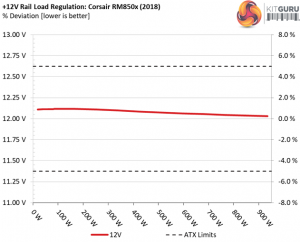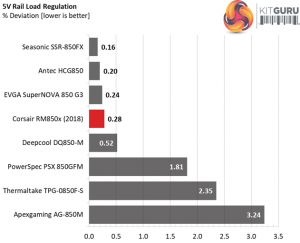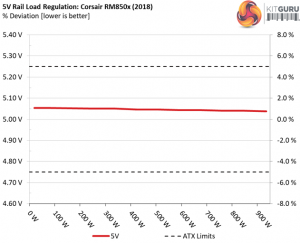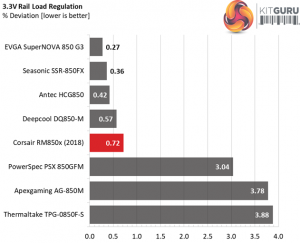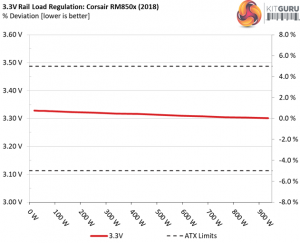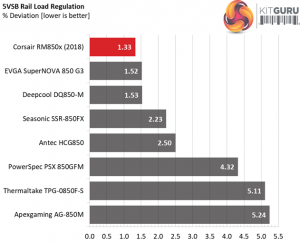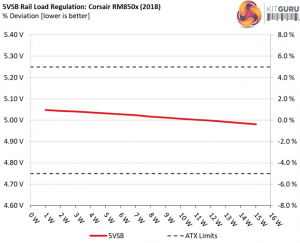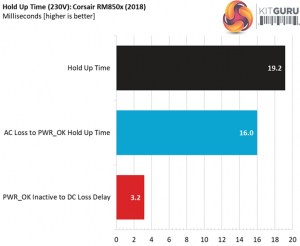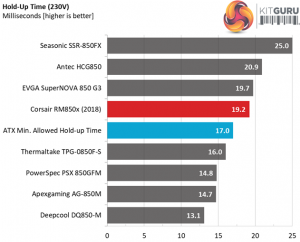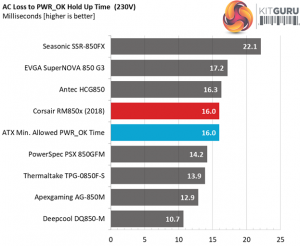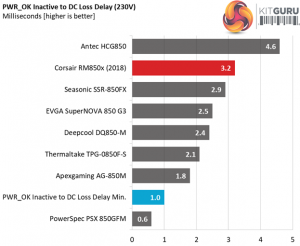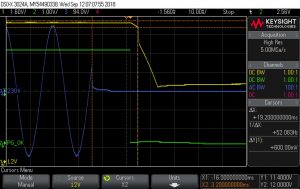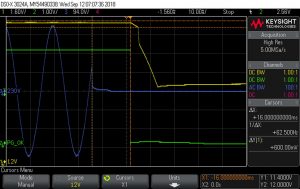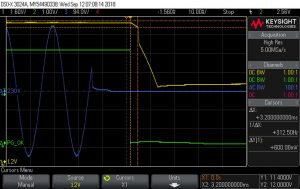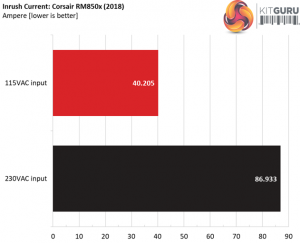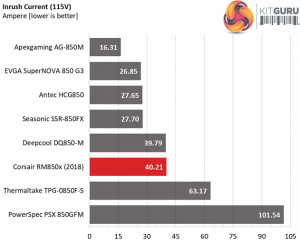To learn more about our PSU tests and methodology, please check out How We Test Power Supply Units.
Primary Rails And 5VSB Load Regulation
Load Regulation testing is detailed here.
Hold-Up Time
Our hold-up time tests are described in detail here.
The oscilloscope screenshots that we took during the hold-up time measurements:
The hold-up time is longer than 17ms and the power-ok signal is accurate and right on spot, at 16ms.
Inrush Current
For details on our inrush current testing, please click here.
The inrush current is quite high with both voltage inputs, especially with 230V.
Load Regulation And Efficiency Measurements
The first set of tests reveals the stability of the voltage rails and the RM850x’s efficiency. The applied load equals (approximately) 10 to 110 percent of the power supplies maximum load in increments of 10 percentage points.
We conducted two additional tests.
During the first, we stressed the two minor rails (5V and 3.3V) with a high load, while the load at +12V was only 0.1A. This test reveals whether a power supply is compatible with Intel’s C6/C7 sleep states or not. In the second test, we determined the maximum load the +12V rail could handle with minimal load on the minor rails.
| Test # | 12V | 5V | 3.3V | 5VSB | DC/AC (Watts) | Efficiency | Fan Speed (RPM) | PSU Noise (dB[A]) | Temps (In/Out) | PF/AC Volts |
| 1 | 5.225A | 1.980A | 1.985A | 0.994A | 84.913 | 86.974% | 0 | <6.0 | 47.19°C | 0.970 |
| 12.115V | 5.054V | 3.326V | 5.032V | 97.630 | 40.12°C | 115.05V | ||||
| 2 | 11.434A | 2.970A | 2.977A | 1.194A | 169.435 | 90.199% | 0 | <6.0 | 48.54°C | 0.985 |
| 12.116V | 5.052V | 3.323V | 5.028V | 187.846 | 40.99°C | 115.05V | ||||
| 3 | 18.046A | 3.466A | 3.464A | 1.394A | 254.532 | 91.416% | 0 | <6.0 | 49.23°C | 0.991 |
| 12.109V | 5.051V | 3.321V | 5.023V | 278.433 | 41.17°C | 115.05V | ||||
| 4 | 24.673A | 3.962A | 3.978A | 1.595A | 339.754 | 91.411% | 0 | <6.0 | 50.97°C | 0.988 |
| 12.100V | 5.050V | 3.318V | 5.017V | 371.676 | 41.78°C | 115.05V | ||||
| 5 | 30.991A | 4.955A | 4.977A | 1.796A | 425.070 | 90.984% | 610 | 10.2 | 41.98°C | 0.989 |
| 12.086V | 5.047V | 3.316V | 5.012V | 467.194 | 51.88°C | 115.05V | ||||
| 6 | 37.258A | 5.948A | 5.977A | 1.998A | 509.599 | 90.471% | 610 | 10.2 | 42.61°C | 0.990 |
| 12.072V | 5.046V | 3.313V | 5.007V | 563.272 | 53.01°C | 115.05V | ||||
| 7 | 43.589A | 6.942A | 6.978A | 2.200A | 594.887 | 89.808% | 610 | 10.2 | 43.30°C | 0.991 |
| 12.062V | 5.044V | 3.310V | 5.002V | 662.398 | 54.30°C | 115.05V | ||||
| 8 | 49.928A | 7.935A | 7.982A | 2.402A | 680.257 | 88.988% | 888 | 22.2 | 43.90°C | 0.993 |
| 12.054V | 5.043V | 3.308V | 4.998V | 764.437 | 55.60°C | 115.04V | ||||
| 9 | 56.673A | 8.434A | 8.472A | 2.402A | 765.203 | 88.194% | 1130 | 30.3 | 44.46°C | 0.994 |
| 12.046V | 5.041V | 3.305V | 4.998V | 867.641 | 56.50°C | 115.04V | ||||
| 10 | 63.158A | 8.931A | 8.994A | 3.013A | 850.023 | 87.226% | 1415 | 36.7 | 46.20°C | 0.995 |
| 12.038V | 5.040V | 3.303V | 4.981V | 974.511 | 58.61°C | 115.04V | ||||
| 11 | 70.244A | 8.935A | 8.998A | 3.014A | 934.759 | 86.187% | 1440 | 37.1 | 46.71°C | 0.996 |
| 12.030V | 5.038V | 3.301V | 4.979V | 1084.566 | 59.59°C | 115.03V | ||||
| CL1 | 0.146A | 18.004A | 17.999A | 0.000A | 152.460 | 81.936% | 714 | 16.5 | 41.96°C | 0.985 |
| 12.097V | 5.053V | 3.318V | 5.102V | 186.071 | 51.73°C | 115.06V | ||||
| CL2 | 70.846A | 1.000A | 1.000A | 1.000A | 866.348 | 87.734% | 1300 | 34.5 | 46.78°C | 0.995 |
| 12.040V | 5.041V | 3.306V | 5.015V | 987.473 | 58.74°C | 115.04V |
The load regulation is tight on all rails and the fan profile is super relaxed even under extremely stressful conditions. Moreover, the semi-passive operation lasts for quite long and doesn't seem to be affected by high operating temperatures. Although there are no heatsinks in the secondary side, CWT's platform doesn't seem to have any problem at all under increased temperatures.
The 80 PLUS Gold requirements with 20%, 50% and full load are easily met even with the tough conditions that we apply. This is something that we don't see everyday.
 KitGuru KitGuru.net – Tech News | Hardware News | Hardware Reviews | IOS | Mobile | Gaming | Graphics Cards
KitGuru KitGuru.net – Tech News | Hardware News | Hardware Reviews | IOS | Mobile | Gaming | Graphics Cards


